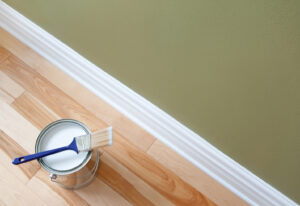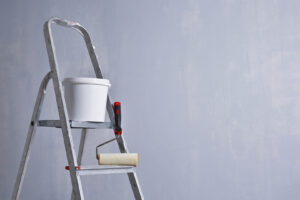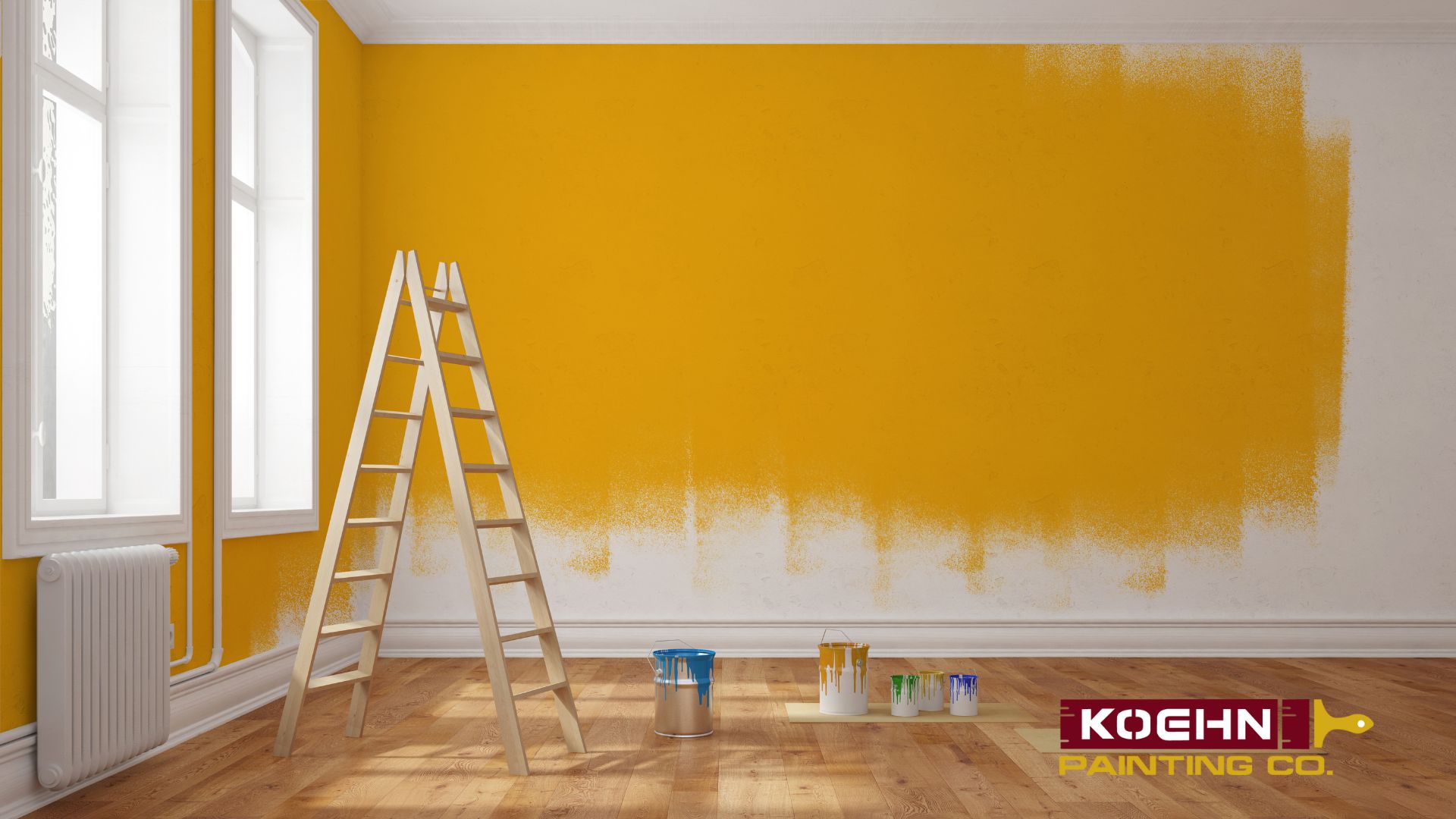Table of Contents
ToggleOn average, professional painting of a room ranges from $300 to $1,000, varying by room size, wall height, and if the ceiling and trim are included. Labor charges are generally $1 to $3 per square foot. If you want to learn how to paint a room yourself, the cost typically falls between $150 and $300.
How to Paint a Room: Materials Needed

In the process of learning how to paint a room, one must first begin by gathering all the right tools and materials. Here is a detailed list to ensure you have everything you need for a smooth painting process:
- Step and Extension Ladders: Essential for reaching high areas.
- Paint Scraper: Removes loose or peeling paint from various surfaces.
- Triangular-Load Scraper: Ideal for removing paint in small or confined spaces.
- Steel Wool: Used to remove corrosion from metal surfaces.
- Bristle Brush: Clears loose materials from masonry.
- Wire Brush: Effective for removing efflorescence and flaking paint from masonry.
- Putty Knives (standard and broad): Scrape loose paint and apply or smooth filler and patching compounds.
- Glazing Compound: Repairs cracked or missing glass panes.
- Spackling Paste: Fills nail holes and minor wall imperfections.
- Long-Handled Brush: Cleans large exterior surfaces.
- Scrub Brush: Removes mildew and dirt.
- Sandpaper and Sanding Block: Smoothens surfaces and prepares them for painting.
- Caulking Gun and Tubes of Caulk: Seals cracks, gaps, and seams in various surfaces.
- Masking Tape: Protects windows and trim from paint.
- Paint Guide: Shields carpets and walls while painting trim.
- Roller Tray and Grid: Assists in loading paint onto rollers.
- Brush Comb: Cleans paint brushes.
- Paint Pail: Mixes and transports paint.
- Drop Cloths: Protects furniture and floors from paint spills.
Let’s go into detail:
1. Paint: The choice between water-based and oil-based paints will affect the application process and result. If you’re learning how to paint a room, it’s important to know that water-based paints are popular because they are easier to work with, dry quickly, and can be cleaned with just soap and water. They are a great choice for most interior spaces. On the other hand, oil-based paints are prized for their durability and stain resistance, making them suitable for high-traffic areas or surfaces that see a lot of wear and tear. However, they take longer to dry and require turpentine or thinner for cleaning.
Use a paint calculator, like the one available online at Lowe’s, to determine the number of gallons needed for your room, accounting for two coats.
2. Brushes: Invest in a variety of brush sizes. Smaller brushes (1-2 inches) are great for fine work around corners and moldings, while larger brushes (3 inches or wider) are better for quickly covering large surfaces. Choose brushes with synthetic bristles for water-based paints and natural bristles for oil-based paints.
3. Rollers: Rollers are your best friend when you need to cover large, flat areas efficiently. A standard 9-inch roller should be sufficient for most rooms, but you may want a smaller 4-6-inch roller for smaller spaces and around appliances. The pile, or thickness of the roller cover, should be chosen based on the texture of the walls: smooth covers for flat walls and thicker piles for textured surfaces.
4. Painter’s tape: essential for getting crisp, clean edges. Tape baseboards, trim, and any areas where the ceiling meets the walls. Be sure to press the tape firmly to prevent paint from seeping underneath.
5. Drop Sheets: Lay down drop sheets to protect floors and furniture from drips and spills. Canvas sheets are more resistant and less slippery than plastic ones, offering better protection and safety.
6. Sandpaper: Use sandpaper to smooth rough surfaces or scratch shiny surfaces to ensure the paint adheres properly. Start with a coarser grit for rougher areas and finish with a finer grit for a smooth base.
7. Primer: A good primer can make a big difference, mainly when painting over dark colors with lighter colors or applying a new coat to new drywall. The primer helps ensure even coverage and maximizes topcoat adhesion, resulting in a nicer, more durable finish.
Choose the Right Paint
When choosing the best paint, consider the room’s function and the type of finish you want. Matte and eggshell finishes are low-gloss and ideal for living rooms and bedrooms, as they hide imperfections well. Satin or semi-gloss finishes are best suited for kitchens and bathrooms due to their durability and moisture resistance.
- Color choice: The color you choose for a room plays a significant role in defining its atmosphere and influencing its perceived size and warmth.
- Consider lighting: Paint colors can appear very different under various lighting conditions. Natural daylight will reveal the most authentic color, making it the best light to judge your paint sample. Incandescent lighting tends to enhance warm tones, making reds, yellows, and oranges more vivid. In contrast, fluorescent lighting adds a bluish tone to colors, which can significantly alter the appearance of paint. To avoid surprises, apply paint samples to different walls and see how they change throughout the day as the lighting changes.
- Room size and scale: The perception of space within a room can be greatly influenced by color. Light colors generally make a room feel larger and more open, while dark colors can create a sense of coziness. Bold colors can be striking and evoke strong emotions; they are often best used on an accent wall or in rooms where a dramatic effect is desired, such as dining or powder rooms.
Painting finishes
The paint finish not only affects the appearance but also the durability of the walls.
- Matte: This finish offers a non-reflective surface that is excellent for hiding stains and wall imperfections. When learning how to paint a room, you’ll find that it gives walls a soft, clean look but is best used in low-traffic areas such as adult bedrooms and formal living rooms because it is less resistant to marks and more difficult to clean.
- Eggshell: Slightly more lustrous than matte, the eggshell finish offers a low sheen and is best suited to moderately trafficked areas. It is easier to clean than matte and works well in living rooms, dining rooms, and bedrooms.
- Satin: With a velvety sheen, the satin finish is popular for its cleanability and delicate sheen. It holds up to cleaning and light scrubbing better than matte or eggshell, making it ideal for high-traffic areas or children’s rooms.
- Semi-Gloss: This finish offers a high level of durability and a noticeable shine, making it an excellent choice for moldings, cabinets, kitchens, and bathrooms. It is highly resistant to moisture and can be cleaned easily, making it practical for areas prone to stains and spills.
- Lustre: The glossy finish is highly reflective and durable, making it an excellent choice for areas that require frequent washing or are subject to wear and tear. When learning how to paint a room, you might consider using this finish for trim, woodwork, and furniture. However, due to its high reflectivity, it can highlight imperfections, so surface preparation is key.
These are the steps you need to follow:
- Protect yourself: When learning how to paint a room and preparing your walls for a fresh coat of paint, including sanding, it’s crucial to wear safety goggles and a face mask or respirator to shield yourself from harmful particles. This is particularly important in homes built before 1978 due to the potential presence of lead paint. Even though modern paints often contain low levels of VOCs (volatile organic compounds), it’s still advisable to protect your eyes and lungs by wearing appropriate gear. For better ventilation, open a window during the painting process and leave it slightly open until the paint has fully dried.
- Cleaning the walls: Before anything else, you must thoroughly clean your walls. Over time, walls accumulate dust, dirt, and greasy fingerprints that can interfere with paint adhesion. Use a mild detergent or sugar soap mixed with water to scrub the walls gently. A slightly more abrasive cleaner may be needed for areas with stubborn stains, but be gentle to avoid damaging the wall surface. Rinse the walls with clean water to remove any soap residue and let them dry completely before proceeding.
- Repairing Holes and Cracks: When learning how to paint a room, start by inspecting the walls for any imperfections, such as nail holes, dents, or cracks. Fill these defects with stucco or a patching compound suitable for your wall type. Apply the putty using a putty knife, pressing it firmly into the hole or crack. Let the grout dry according to the manufacturer’s instructions – this may take a few hours or overnight, depending on the product. Once dry, use sandpaper to sand the patched areas until they are flush with the rest of the wall. This step is critical to ensuring a seamless finish under the new paint.
- Taping and covering: Protecting the areas you don’t want to be painted is as important as the painting itself. Apply masking tape to trim, windowsills, door frames, and any other surface where the walls meet a different material. Be precise and press the edges of the tape down to prevent paint from seeping underneath. To cover the floor, opt for canvas sheets, safer and more effective than plastic because they do not slip and absorb paint drops. If you must protect large furniture, consider using large, lightweight plastic sheeting or old sheets.
- Lighting and ventilation control: Good lighting is essential to seeing the actual condition of the walls and ensuring an even paint application. If the natural light in the room is insufficient, use additional lamps. Adequate ventilation will help reduce paint fumes, especially if you use oil-based types. Open windows and doors and, if necessary, use fans to keep air circulating.
- Final inspection: Pay one last visit to your space. Make sure all repairs are smooth, surfaces are clean, and everything is properly covered and taped. This final check will help you avoid any mid-project mishaps and set the stage for the actual painting.
Painting Techniques

Painting walls, ceilings, and trim
- Walls: Start painting from the ceiling to avoid drips on freshly painted walls. When using a roller, attach it to an extension pole to comfortably reach higher areas. Apply paint in W- or M-shaped patterns on small sections at a time. This technique helps distribute the paint evenly and minimizes marks. Use a smaller brush to cut around corners and edges close to the trim, ensuring clean lines and even coverage.
- Ceilings: Similar techniques apply to ceilings, but consider using a roller with a thicker nap to handle the ceiling texture better and absorb more paint, reducing the likelihood of drips. Since working overhead is more physically demanding, be sure to take regular breaks and maintain a steady pace to ensure even application.
- Trim: To keep the lines crisp and clean, it’s usually best to tackle the trim after finishing the walls and ceiling. Use a small, high-quality angled brush for better control and precision, especially around window frames, doors, and baseboards. Paint the trim steadily with long, flowing strokes to minimize brush marks and achieve a professional look.
Brush versus roller
- Brushes are ideal for detailed, smaller areas where precision is key. If you’re learning how to paint a room, you’ll find that brushes are perfect for cutting into corners, painting trim, and working around window frames. They allow for greater control and can reach tight spaces that a roller cannot.
- Rollers are best suited for quickly covering large, flat surfaces. When figuring out how to paint a room efficiently, remember that rollers provide a more even coat than brushes and are more efficient for painting large areas such as walls and ceilings. Choose the right size and thickness of the pile based on the texture of the surface you are painting.
Tips for a smooth finish
- Don’t overload your brush or roller with paint. Excess paint leads to drips and uneven application. Dip the brush only about a third of the way into the paint and pat away the excess. With a roller, use the rolling grid in the paint tray to remove excess.
- When using a brush, paint all strokes in the same direction for a consistent finish. With a roller, maintain a steady “up and down” motion instead of zigzagging across the surface.
- Apply painter’s tape to straight edges, but be sure to remove it while the last coat of paint is still slightly wet. This prevents the paint from coming off the tape and helps create a crisp, clean line.
- Multiple thin layers: Instead of one thick layer, apply several thin layers. Thin layers dry faster and more evenly, reducing the likelihood of runs or texture issues. Allow each layer to dry completely per the manufacturer’s instructions before applying the next one. This method is essential when mastering how to paint a room effectively.
Drying and re-coating
Understanding the drying times of different types of paint is critical to effectively planning your painting project and can prevent potential problems such as smudging or peeling.
- Most water-based paints dry to the touch within about an hour, meaning the surface will not feel wet if touched lightly. However, the paint takes longer to cure before applying a second coat, typically four to six hours. This quick drying time allows you to complete a project in a shorter period.
- Oil-based paints have longer drying times. They generally dry to the touch in six to eight hours but require up to 24 hours before applying a second coat.
- Water-based acrylic paint: Dries in 30 min – 1.5 hrs, fully cures in 14 – 30 days.
- Oil/solvent-based paint: Dries in 6 – 8 hrs, fully cures in 7 – 15 days.
- Water-based PU paint: Dries in 2 – 4 hrs, fully cures in 10 – 15 days.
- Oil-based PU paint: Dries in 24 – 48 hrs, fully cures in 15 – 30 days.
- Epoxy paint: Dries in 24 – 48 hrs, fully cures in 4 – 30 days.
- Lacquer: Dries in 30 min – 2 hrs, fully cures in 15 days – 2 months.
Signs for lining
It’s important to know when it’s safe to apply another layer of paint to avoid ruining the first layer or getting a less-than-satisfactory finish.
- Tackiness: Test the first coat by applying light pressure with your finger on the painted surface. If the paint is no longer tacky, it is usually safe to apply another coat. If the paint still feels tacky, it will need more time to dry.
- Indentation test: Gently press the paint with your fingertip or small tool. If the paint leaves no indentations, it is probably ready to be repainted.
- Uniformity of color and shine: observe the paint under good lighting. The color and sheen should be uniform across the entire surface. Any areas that appear darker or shinier than others may still be wet.
- The margin of safety: If you are unsure, it is always best to wait longer than the minimum drying time recommended by the paint manufacturer. Allowing more time ensures that the paint hardens completely, improving its durability and the quality of the finish.
- Humidity and Temperature: High humidity and low temperatures can extend the drying time of paint. Always check the weather if you’re painting an area exposed to the elements, and make sure your interior space is well-ventilated but free of drafts that could cause dust to stick to the paint.
- Ventilation: Good ventilation helps speed up the drying process, especially for oil-based paints, which can emit more pungent fumes.
- Test small areas: When in doubt, consider testing the prep for a new coat on a small, inconspicuous wall area. This method avoids ruining the entire job due to impatience or incorrect drying times.
Cleanup and Maintenance

Correct cleaning of brushes and rollers
- Brushes: When learning how to paint a room, proper brush care is crucial. For water-based paints, rinse brushes thoroughly in water to remove most of the paint, then wash them with mild soap and warm water until the water runs clear. For oil-based paints, you will need a solvent such as mineral spirits to dissolve the paint before washing it with soap and water. After cleansing, wipe away excess moisture and use your fingers to gently reshape the bristles. This helps keep your toothbrush in good condition for future use.
- Rollers: Start by scraping off as much paint as you can and placing it back into the paint can or onto a scrap piece of cardboard. For water-based paints, rinse the roller sleeve under running water and use your hands to wring out the paint. For oil-based paints, use the appropriate solvent to rinse the paint, then wash with soap and water if necessary. After cleaning, hang the rollers to dry to maintain their shape and prevent mold or mildew from forming.
Advanced Painting Tips and Tricks
Sponging
- Tools: a sea sponge or a synthetic sponge with a similar structure.
- Method: First, apply a solid base coat and let it dry completely. Lightly dip the sponge in a contrasting nail polish or a lighter/darker shade of the base color. Blot any excess on a piece of cardboard to avoid over-saturation. Gently press the sponge against the wall randomly or deliberately, depending on the desired effect. This technique adds depth and texture, creating a dynamic look.
- Tip: Rotate the sponge periodically to avoid repetitive patterns, which could make the work look unnatural.
Stencils
- Tools: Stencils can be purchased, or homemade.
- Method: Attach the stencil to the wall using masking tape. Use a minimal amount of paint on your brush or roller—too much paint can seep under the stencil, creating blurry lines. Apply the paint with a patting or rolling motion.
- Tip: Practice on a piece of cardboard first to get the right amount of paint and pressure, ensuring crisp edges.
How To Deal with Challenging Spaces

High walls
- Tools: Extension poles can be attached to rollers or brushes to extend the reach. Consider renting scaffolding for very high walls or large spaces to provide a stable base.
- Technique: When using an extension rod, keep the rod as perpendicular to the wall as possible to ensure even pressure and coverage. If you use scaffolding, move it regularly to keep the work area directly in front of you to maintain control and accuracy.
- Safety Tip: Always ensure the scaffolding is safe and stable, and avoid leaning excessively on a ladder.
Structured surfaces
- Tools: Thicker pile rollers (¾ inch to 1 inch) are best suited for very rough surfaces as they can scratch reach cracks and uneven areas more effectively.
- Technique: apply paint in multiple directions. By rolling both vertically and horizontally (or even diagonally), you can better ensure that all cracks and bumps are adequately covered.
- Tip: Consider using a base coat of a similar color if the new topcoat is significantly lighter than the existing color. This can prevent the old color from showing through the texture.
How to store leftover paint
- Seal the can: Properly sealing the remaining paint can significantly extend its life. To seal the paint can, place a piece of wood over the lid and gently tap around the edges with a hammer to ensure the lid is tightly closed. This method helps prevent air from entering the can, which could cause the paint to dry out or form a film.
- Storage Conditions: Store sealed paint in a cool, dry place, away from direct sunlight and extreme temperatures. Excessive heat or cold can alter the texture and color of the paint.
- Labeling: Label each can with important details such as the date of purchase, name and color code, and the room in which it was used. This is especially useful for touch-ups or if you need to purchase more paint in the future.
Discover the Koehn Painting difference – contact us today for a free estimate and step into a vibrant, freshly painted home!





